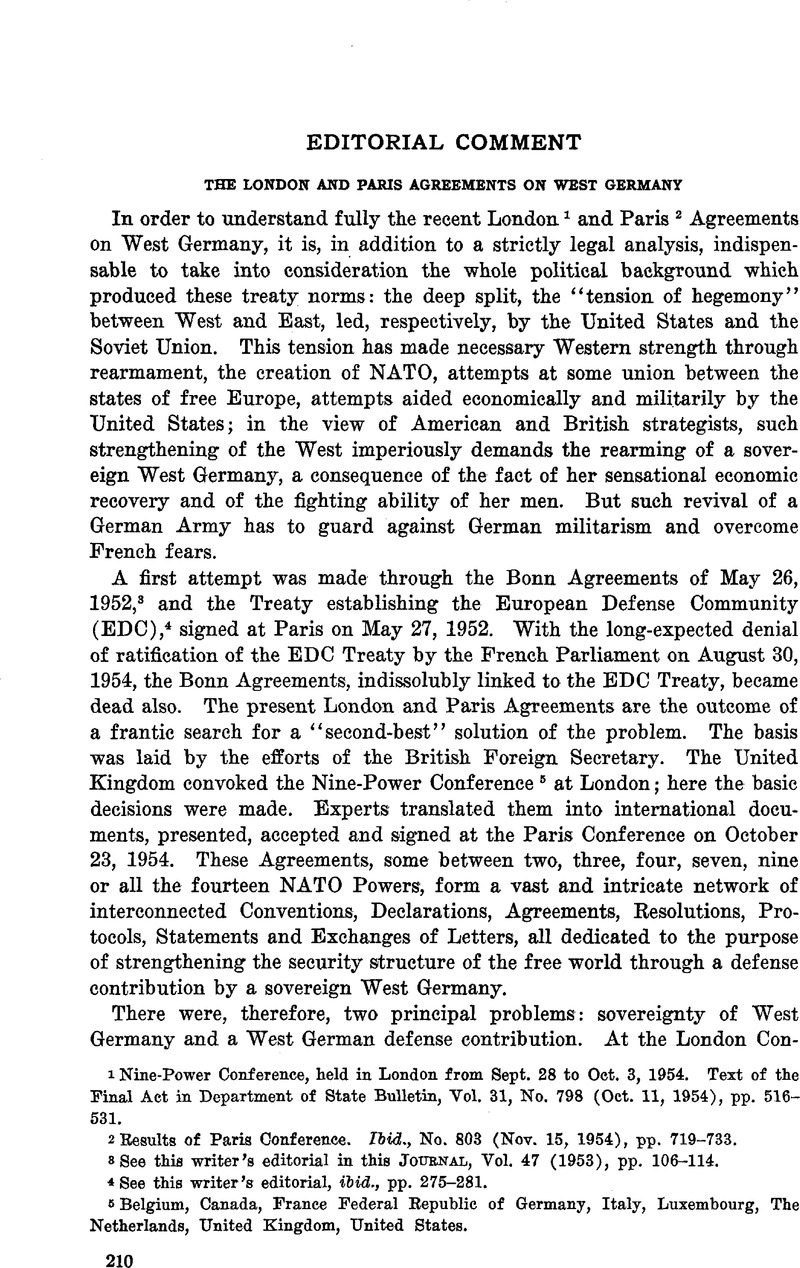Article contents
The London and Paris Agreements on West Germany
Published online by Cambridge University Press: 30 March 2017
Abstract

- Type
- Editorial Comment
- Information
- Copyright
- Copyright © American Society of International Law 1955
References
1 Nine-Power Conference, held in London from Sept. 28 to Oct. 3, 1954. Text of the Final Act in Department of State Bulletin, Vol. 31, No. 798 (Oct. 11, 1954), pp. 516–531.
2 Results of Paris Conference. Ibid., No. 803 (Nov. 15, 1954), pp. 719–733.
3 See this writer’s editorial in this Journal, Vol. 47 (1953), pp. 106–114.
4 See this writer’s editorial, ibid., pp. 275–281.
5 Belgium, Canada, France Federal Republic of Germany, Italy, Luxembourg, The Netherlands, United Kingdom, United States.
6 See also the Report of the Secretary of State to the President of Nov. 12, 1954 (Department of State Bulletin, Vol. 31, No. 806 (Dee. 6, 1954), pp. 849–856).
7 Convention on the Rights and Obligations of Foreign Forces, Finance Convention, Convention on the Settlement of Matters Arising out of the War and Occupation. Texts in Senate Execs. Q and R, 82nd Cong., 2nd Sess., Washington, 1952.
8 Texts in London and Paris Agreements, September-October 1954 (Department of State Publication 5659, International Organization and Conference Series II (European and British Commonwealth), 5), pp. 65–94.
9 Text in Department of State Bulletin, Vol. 18, No. 462 (May 9, 1948), and reprinted ibid., Vol. 31, No. 798 (Oct. 11, 1954), pp. 528–530. See this writer’s editorial in this JournalVol. 42 (1948), pp. 868–877.
10 Signed at Washington April 4, 1949.
11 Just as the British-Soviet Treaty of 1942, the French-Soviet Treaty of Dec. 10, 1944, concluded for twenty years by the provisional regime of General Charles de Gaulle, and the British-French Treaty of Dunkirk of 1947.
12 In the Preamble and in Art. VII.
13 As detailed in Annex II to Art. 107 of the EDC Treaty.
14 Namely, long-range missiles, guided missiles and influence mines, naval vessels other than minor defensive craft, and military aircraft. Any amendments as to these weapons can, on the request of West Germany, be carried out by a two-thirds majority of the Brussels Council of Ministers, if a request to this effect is made to NATO.
15 A Director, a Deputy Director and a staff, drawn equitably from nationals of the Brussels Treaty Powers. The Director shall submit to the Council a plan for the organization of the Agency. The Agency will have departments for its different tasks: departments dealing with the examination of statistical and budgetary information, inspection, test checks, and administration.
16 All deployment of troops shall be in accordance with NATO strategy; the location of forces is to be determined by SACEUK after consultation with the national authorities concerned; these forces shall not be redeployed or used operationally without the consent of SACEUB. The integration of forces will, as a rule, remain at Army Group and Tactical Air Force level. The powers and responsibilities of SACEUB for the logistic support of the forces placed under its authority will be increased; SACEUB will also have control over higher training of all national forces assigned to its command in peacetime. The “area” of SACEUB will not include North Africa.
17 English text in New York Times, Oct. 26, 1954, p. 4.
18 In his televised report to the President and the Cabinet at the White House on Oct. 25, 1954. Department of State Publication 5659, p. 7.
19 See Adenauer, Konrad, “Germany, the New Partner,” in Foreign Affairs, Vol. 33 (1955), pp. 177–183.CrossRefGoogle Scholar
- 2
- Cited by




